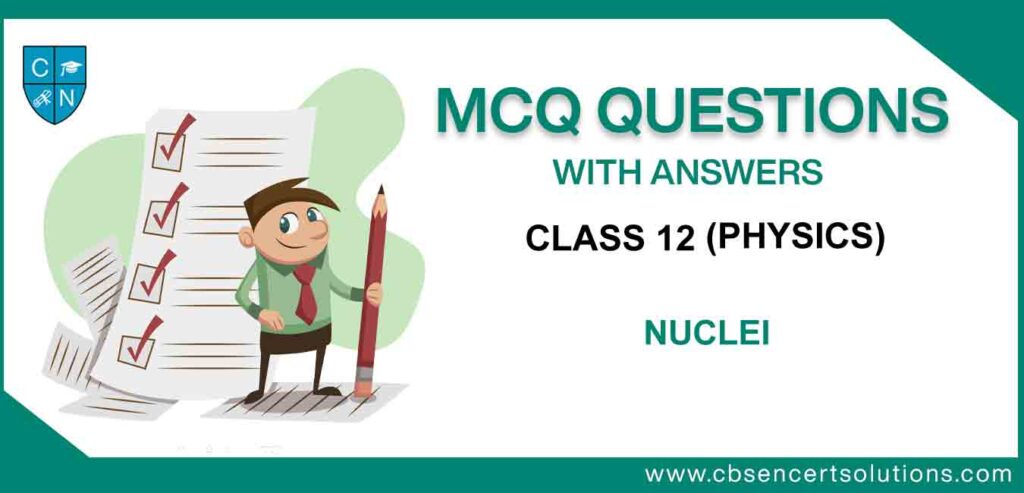Refer to MCQ Questions for Class 12 Nuclei provided below which is an important chapter in Class 12 Physics. Students should go through the MCQs questions for Class 12 Physics Chapter 13 Nuclei with answers given below so that they are able to understand the complete topic properly. It’s important to understand the entire chapter by reading Class 12 Physics Notes also. Also, refer to MCQ Questions for Class 12 Physics for all chapters.
MCQ on Nuclei Class 12 Physics PDF with Answers
All multiple choice questions with solutions provided below have been developed based on the latest syllabus and examination pattern issued for class 12 by CBSE and NCERT. As Nuclei is a very important and scoring chapter in Physics Class 12, therefore, the students should carefully learn the questions and answers given below which will help them to get better scores in upcoming examinations for class 12th.
Question In the nuclear reaction, there is a conservation of:
(a) momentum
(b) mass
(c) energy
(d) all of these
Answer
A
Question. If the radioactive decay constant of radium is 1.07 × 10–4 per year. Then its half life period approximately is equal to:
(a) 5000 years
(b) 6500 years
(c) 7000 years
(d) 8900 years
Answer
B
Question. In 88Ra226 nucleus there are :
(a) 226 protons and 88 electrons
(b) 138 protons and 88 neutrons
(c) 226 neutrons and 138 electrons
(d) 138 neutrons and 88 protons
Answer
D
Question. The activity of radioactive sample is measured as 9750 counts per minute at t = 0 and as 975 counts per minute at t = 5 minutes, the decay constant is approximately :
(a) 0.922 per minute
(b) 0.270 per minute
(c) 0.461 per minute
(d) 0.39 per minute
Answer
C
Question. The activity of a radioactive sample is 1.6 curie and its half life is 2.5 days. Then activity after 10 days will be :
(a) 0.16 curie
(b) 0.8 curie
(c) 0.1 curie
(d) 0.4 curie
Answer
C
Question. Which one of the following is used as a moderator in nuclear reaction ?
(a) Uranium
(b) Heavy water
(c) Cadmium
(d) Plutonium
Answer
B
Question. The reaction responsible for the production of light energy from the sun will be:
(a) fission
(b) fusion
(c) nuclear
(d) none of these
Answer
B
Question. Half life of a substance is 20 minutes, then the time between 33 % decay and 67 % decay will be
(a) 20 minute
(b) 40 minute
(c) 50 minute
(d) 10 minute
Answer
A
Question. Consider the following nuclear reaction X200 → A110 + B90 + Energy
If the binding energy per nucleon for X, A and B are 7.4 MeV, and 8.2 MeV and 8.2 MeV respectively, the energy released will be :
(a) 90 MeV
(b) 110 MeV
(c) 200 MeV
(d) 160 MeV
Answer
D
Question. In each fission of 92U235 releases 200 MeV, how many fissions must occur per second to produce power of 1 kW ?
(a) 1.25 × 1018
(b) 3.125 × 1013
(c) 3.2 × 1018
(d) 1.25 × 1013
Answer
B
Question. The function of heavy water in a nuclear reactor to
(a) slow down the neutrons
(b) increase the neutrons
(c) stop the electrons
(d) none of these
Answer
A
Question. Which one of the following has the highest neutrons ratio ?
(a) 92U235
(b) 8O16
(c) 2He4
(d) 26Fe56
Answer
A
Question. When radioactive substance emits an a-particle, then its position in the periodic table is lowered by
(a) two places
(b) three places
(c) five places
(c) one place
Answer
A
Question. In an atom bomb, the energy is released because of the :
(a) chain reaction of neutrons and 92U238
(b) chain reaction of neutrons and 92U235
(c) chain reaction of neutrons and 92U236
(d) chain reaction of neutrons and 92U240
Answer
B
Question. A radioactive substance decays to 1/16th of its initial activity in 40 days. The half-life of the radioactive substance expressed in days is
(a) 2.5
(b) 5
(c) 10
(d) 20
Answer
C
Question. Nuclear fusion is possible
(a) only between light nuclei
(b) only between heavy nuclei
(c) between both light and heavy nuclei
(d) only between nuclei which are stable against b-decay
Answer
A
Question. Radioactive nuclei that are injected into a potient collected at certain sites within its body, undergoing radioactive decay and emitting electromagnetic radiation. These radiations can then be recorded by a detector. This procedure provides an important diagnostic tools called
(a) Gamma camera
(b) CAT can
(c) Radiotracer technique
(d) Gamma ray spectroscopy
Answer
C
Question. In a material medium, when a positron meets an electron both the particles annihilate leading to the emission of two gamma ray photons. This process forms the basis of an important diagnostic procedure called
(a) MRI
(b) PET
(c) CAT
(d) SPECT
Answer
B
Question. Carbon dating is best suited for determining the age of fossils if their age in years is of the order of
(a) 103
(b) 104
(c) 105
(d) 106
Answer
B
Question. When an electron-positron pair annihilates, the energy released is about
(a) 0.8 × 10–13 J
(b) 1.6 × 10–13 J
(c) 3.2 × 10–13 J
(d) 4.8 × 10–13 J
Answer
B
Question. A radioactive material has half-life of 10 days.What fraction of the material would remain after 30 days ?
(a) 0.5
(b) 0.25
(c) 0.125
(d) 0.33
Answer
C
Question. The operation of a nuclear reactor is said to be critical, if the multiplication factor (K) has a value
(a) 1
(b) 1.5
(c) 2.1
(d) 2.5
Answer
A
Question. 238U has 92 protons and 238 nucleons. It decays by emitting an Alpha particle and becomes
(a) 23492U
(b) 234 90Th
(c) 23592U
(d) 23793Np
Answer
B
Question. If Alpha, Beta and Gamma rays carry same momentum, which has the longest wavelength
(a) Alpha rays
(b) Beta rays
(c) Gamma rays
(d) None, all have some wavelength
Answer
D
Question. What is the amount of energy released by deuterium and tritium fusion?
(a) 60.6 eV
(b) 123.6 eV
(c) 17.6 eV
(d) 28.3 eV
Answer
C
Question. Calculate power output of 23592U reactor, if it takes 30 days to use up 2 kg of fuel, and if each fission gives 185 MeV of useable energy. Avogadro’s number = 6 × 1023 /mol?
(a) 56.3 MW
(b) 60.3 MW
(c) 58.3 MW
(d) 54.3 MW
Answer
C
Question. Starting with a sample of pure 66Cu,7/8 of it decays into Zn in 15 minutes. The corresponding half life is
(a) 15 minutes
(b) 10 minutes
(c) 7 .1/2 minutes
(d) 5 minutes
Answer
D
Question. A radioactive material decays by simultaneous emission of two particles with respective halflives 1620 and 810 years. The time, in years, after which one-fourth of the material reamins is
(a) 1080
(b) 2430
(c) 3240
(d) 4860
Answer
A
Question. If the binding energy per nucleon of a nuclide is high then
(a) It should be abundantly available in nature
(b) It will decay instantly
(c) It will have a large disintegration constant
(d) It will have a small half-life.
Answer
A
Question. Activity of a radioactive sample decreases to (l/3)rd of its original value in 3 days. Then, in 9 days its activity will become
(a) (1/27) of the original value
(b) (1/9) of the original value
(c) (1/18) of the original value
(d) (1/3) of the original value
Answer
A
Question. The half life of a radioactive substance against a -decay is 1.2 × 107 s. What is the decay rate for 4.0 × 1015 atoms of the substance
(a) 4.6 × 10 12 atoms/s
(b) 2.3 × 10 11 atoms/s
(c) 4.6 × 10 10 atoms/s
(d) 2.3 × 10 8 atoms/s
Answer
D
Question. Actinium 231, 231Ac89, emit in succession two b-particles, four alphas, one b and one alpha plus several g rays. What is the resultant isotope:
(a) 221 Au79
(b) 211 Au 79
(c) 221 Pb 82
(d) 211 Pb 82
Answer
D
Question. An archaeologist analyses the wood in a prehistoric structure and finds that C14 (Half life = 5700 years) to C12 is only one-fourth of that found in the cells of buried plants. The age of the wood is about
(a) 5700 years
(b) 2850 years
(c) 11,400 years
(d) 22,800 years
Answer
C
Question. The fossil bone has a 14C : 12C ratio, which is [1/16] of that in a living animal bone. If the halflife of 14C is 5730 years, then the age of the fossil bone is
(a) 11460 years
(b) 17190 years
(c) 22920 years
(d) 45840 years
Answer
C
Question. Which one of the following pairs of nuclei are isotones?
(a) 34Se74, 31Ga71
(b) 38Sr84, 38Sr86
(c) 42Mo92, 40Zr92
(d) 20Ca40, 16S32
Answer
A
Question. A nucleus represented by the symbol Z AX has
(a) Z neutrons and A – Z protons
(b) Z protons and A – Z neutrons
(c) Z protons and A neutrons
(d) A protons and Z – A neutrons
Answer
B
Question. The mass number of a nucleus is
(a) always less than its atomic number
(b) always more than its atomic number
(c) sometimes equal to its atomic number
(d) sometimes less than and sometimes more than its atomic number
Answer
C
Question. Atomic weight of Boron is 10.81 and it has two isotopes 5B10 and 5B11. Then the ratio of 5B10 : 5B11 in nature would be
(a) 15 : 16
(b) 10 : 11
(c) 19 : 81
(d) 81 : 19
Answer
C
Question. The constituents of atomic nuclei are believed to be
(a) neutrons and protons
(b) protons only
(c) electrons and protons
(d) electrons, protons and neutrons
Answer
A
Question. In the nucleus of 11Na23, the number of protons, neutrons and electrons are
(a) 11, 12, 0
(b) 23, 12, 11
(c) 12, 11, 0
(d) 23, 11, 12
Answer
A
Question. The activity of a radioactive sample is measured as 9750 counts per minute at t = 0 & 975 counts per minute at T = 5 minutes. The decay constant is approximately.
(a) 0.922 per minutes
(b) 0.691 per minutes
(c) 0.461 per minutes
(d) 0.230 per minutes
Answer
C
Question. A neutron travelling with a velocity v and kinetic energy E has a perfectly elastic head-on collision with a nucleus of an atom of mass number A at rest. The fraction of total energy retained by the neutron is approximately
(a) [(A – 1)/(A + 1)]2
(b) [(A + 1)/(A – 1)]2
(c) [(A – 1)/A]2
(d) [(A + 1)/A]2
Answer
A
Question. Atomic weight of boron is 10.81 and it has two isotopes 5B10 and 5B11. Then ratio of 5B10 : 5B11 in nature would be
(a) 19 : 81
(b) 10 : 11
(c) 15 : 16
(d) 81 : 19
Answer
A
Question. Which of the following statements is true?
(a) 78Pt192 has 78 neutrons
(b) 84Po214 → 82Pb210 + β–
(c) 92U238 → 90Th234 + 2He4
(d) 90Th234 → 91Pa234 + 2He4
Answer
C
Question. If the radius of a nucleus 256X is 8 fermi, then the radius of 4He nucleus will be
(a) 16 fermi
(b) 2 fermi
(c) 32 fermi
(d) 4 fermi
Answer
B
Question. The energy released per fission of a 92U235 nucleus is nearly
(a) 200 eV
(b) 20 eV
(c) 200 MeV
(d) 2000 eV
Answer
C
Question. Order of magnitude of density of uranium nucleus is (mp = 1.67 × 10–27 kg)
(a) 1020 kg / m3
(b) 1017 kg / m3
(c) 1014 kg / m3
(d) 1011 kg / m3
Answer
B
Question. Consider a radioactive material of half-life 1.0 minute. If one
of the nuclei decays now, the next one will decay
(a) after 1 minute
(b) after (1/loge2) minute
(c) after 1/N minute, where N is the number of nuclei present at that moment
(d) after any time
Answer
D
Question. The masses of neutron and proton are 1.0087 a.m.u. and 1.0073 a.m.u. respectively. If the neutrons and protons combine to form a helium nucleus (alpha particles) of mass 4.0015 a.m.u the binding energy fo the helium nucleus will be (1 a.m.u. = 931 MeV)
(a) 28.4 MeV
(b) 20.8 MeV
(c) 27.3 MeV
(d) 14.2 MeV
Answer
A
Question. At any instant, the ratio of the amount of radioactive substances is 2 : 1. If their half lives be respectively 12 and 16 hours, then after two days, what will be the ratio of the substances ?
(a) 1 : 1
(b) 2 : 1
(c) 1 : 2
(d) 1 : 4
Answer
A
Question. Half lives of two radio active substance A & B are respectively 20 minutes & 40 minutes. Initially the samples of A & B have equal numbers of nulcei. After 80 minutes the ratio of remaining numbers of A & B nuclei is
(a) 1 : 16
(b) 4 : 1
(c) 1 : 4
(d) 1 : 1
Answer
C

We hope that the MCQ Questions for Class 12 Nuclei provided above for all Class 12 Physics students have been very useful for you. If you need more questions then please put your comments below and our teachers will make more questions for Chapter Atoms. Dont forget to refer to multiple choice questions given for other chapters in Class 12 Physics on our website.


